While summer is a popular time to travel, this doesn’t mean travel time ends when summer is over. For many of us, business travel may pick up and for others we may take advantage of off-peak travel costs available over the coming months. Either way, as you plan your itinerary, think about making a pair of compression[…]
One of the most common questions we get here at the Vein Institute of New Jersey is: What is Chronic Venous Insufficiency (CVI)?
Varicose, Spider and now Reticular veins. How are you supposed to know what’s what? Or, more importantly, how to get rid of them?
If you or anyone you know has high blood pressure, diabetes, high cholesterol, or heart disease, or if they smoke cigarettes or have a family history of cardiac disease or stroke, then chances are that Peripheral Artery Disease (PAD) already has or will touch your life.
As Vascular Surgeons, we are frequently asked about the risk of air travel and the development of Deep Vein Thrombosis (DVT) or blood clots. Despite the abundance of warnings in airline brochures and “common knowledge” in the lay press, the scientific evidence is less overwhelming!
At The Cardiovascular Care Group and Vein Institute of New Jersey we care about education and transparency. It has been a proud tradition of ours since our founding in 1963, to ensure sound medical advice and treatments as well as a new outlook on life.













.jpg?width=944&name=Castle-Connolly-Top-Doctors-Emblem-Large%20(4).jpg)